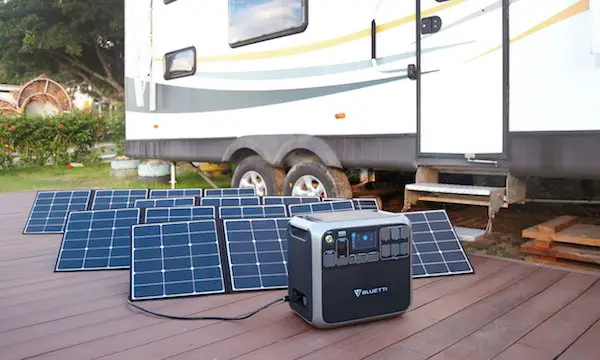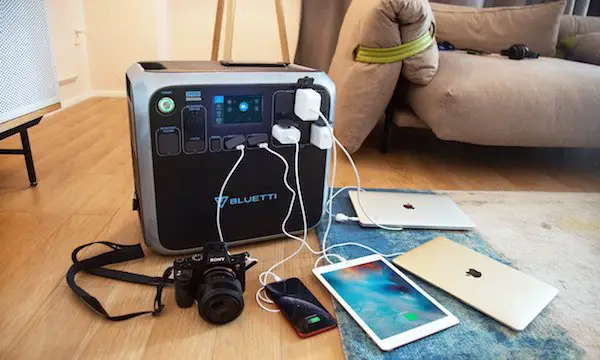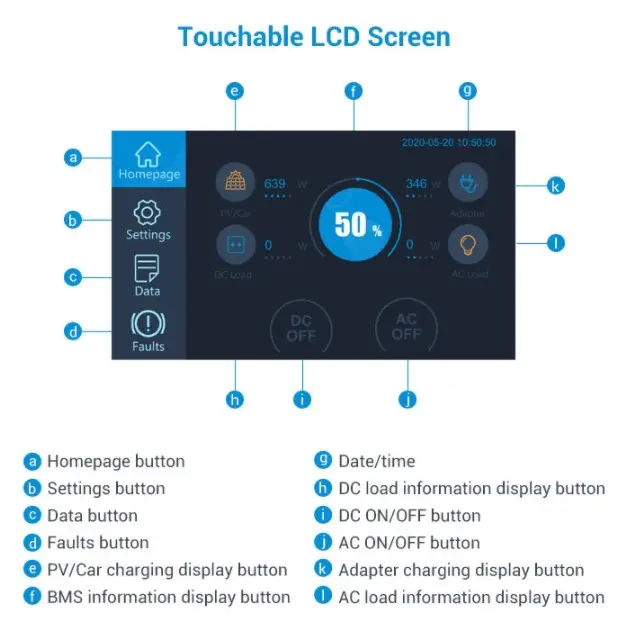The constant need for electricity and power has been the primary precursor for the solar energy industry’s growth and development.
This growth thus allowed for the influx of new manufacturers and expansion of old ones.
Altogether, the industry is in a better position to provide a never-ending supply of electricity to people all over the world.
One of the numerous new players in the solar generator industry is Bluetti. Like its counterparts, the company seeks to provide people with a means to tap into nature’s source of energy.
Thus, the brand has an array of solar energy products, including solar generators, solar panels, and more.
However, this article is focused on reviewing and comparing two of the solar generators produced by this brand.
These solar generators are the Bluetti AC200 and the Bluetti AC200P.
Due to the numerous impressive features and quality of these solar generators, it can be difficult for people to choose between them.
At the end of this article, you will be able to select one of these two solar generators as the best option for you.
The Bluetti AC200P is the better option compared to the AC200. This is because it uses a LiFePO4 battery, equipping it with a longer battery cycle life. The AC200P has 3,500+ charge cycles compared to the AC200’s 2,500+ cycles. Both systems have identical output and input ports.
Bluetti AC200 vs AC200P - General Specifications
| Model | Bluetti AC200 | Bluetti AC200P |
|---|---|---|
| Battery Capacity | 1,700Wh | 2,000Wh |
| Battery Type | Lithium-ion | LiFePO4 |
| Weight | 57 lbs | 60.6 lbs |
| AC Inverter | 2,000W continuous, 4,800W surge | 2,000W continuous, 4,800W surge |
| Cycle Life | 2,500+ cycles to 80% capacity | 3,500+ cycles to 80% capacity |
An Overview of the Bluetti AC200
Anyone well-versed in the solar generator or off-grid power industry knows that the AC200 is a reliable and strong solar generator on the market at the moment. The power station has all the necessary features to provide you with off-grid electricity outdoors and indoors.
Prominent among its exciting features is its lithium-ion battery rated at 1,700Wh. The AC200 also features a powerful 2,000W continuous (4,800W surge) pure sine wave inverter. This inverter eases the process of powering heavy-duty AC appliances without damaging the solar generator or the appliance itself.
However, despite these impressive qualities, the Bluetti AC200 is not easy to purchase. First off, you cannot find it on Bluetti’s website. You can only find it on Indiegogo, where it was crowdfunded and is no longer available on that website. As a result, the Bluetti AC200 is only available in limited quantities from various sellers.
An Overview of the Bluetti AC200P
From the name, it is easy to guess that this product is an upgrade to the Bluetti AC200. Well, the guess is true. The Bluetti AC200P is a step-up product from the AC200, coming with improved features that make it better than its predecessor.
Part of these improved features is the battery with a whooping capacity of 2,000Wh. As if this is not enough, the battery is made from lithium-iron-phosphate (LiFePO4), a safer, longer-lasting battery type than the lithium-ion variation. As a result, you get better battery efficiency and increased cycle life. This allows the battery to last much longer than the lithium-ion battery found in the AC200.
Unlike its predecessor, the AC200P is readily available for purchase. You will find it on Bluetti’s website and other sales platforms.
Key Features
The AC200 and AC200P are similar in many ways, but there are some factors within each system that set one apart from the other. The features we’ll be discussing include:
- Battery Capacity
- Battery Output & Inverter Size
- Size and Portability
- Battery Type
- Charging Mechanisms and Duration
- Number of Ports
- LCD Screen
Now, let’s see how the Bluetti AC200 and AC200P compare to each other.
Battery Capacity Comparison – Bluetti AC200 vs AC200P

The Bluetti AC200P has a higher battery capacity than the AC200. The AC200P has a 2,000Wh battery while the AC200 has a 1,700Wh battery.
Battery capacity simply measures how long the battery will last from a full charge. The higher the battery capacity, the better the ability of the power station to run your equipment for an extended period of time.
The Bluetti AC200 has a battery capacity of 1,700Wh. While the battery capacity is not the highest that we have seen among off-grid power stations, it is still a high number that will be reliable in a power outage.
For example, the AC200 can recharge a typical smartphone over 140 times. It can also run a 40W CPAP machine for over 23 hours on a single charge. Some other solar generator models, like Bluetti’s EP500 and Goal Zero’s Yeti 6000X, can power these devices for a much longer period of time, but they are some of the largest solar generators on the market today and are much larger than the AC200.
On the other end, the Bluetti AC200P comes with a total battery capacity of 2,000Wh. With this capacity, the power station can power numerous appliances and gadgets such as phones, laptop computers, cameras, drones, and refrigerators, to name a few.
Verdict: The Bluetti AC200P has a higher battery capacity than the AC200 by 300Wh, meaning that it can power devices and appliances for a longer duration. The 300Wh increase may not seem like a lot of extra battery power, but when the power goes out at home and you have no other power supply, that extra battery life can come in handy.
AC200 vs AC200P – Inverter Output
The AC200 and AC200P have the exact same inverter output at 2,000W continuous and 4,800W surge. This allows users to run several appliances such as microwaves and blenders with ease.
The inverter is another vital component of the power station, determining the solar generator’s ability to power heavy-duty appliances. The size of an inverter determines its ability to supply a sufficient amount of power to a certain range of devices and appliances. Some inverters found in smaller solar generators, like the Yeti 500X, only have enough AC output power to be used with devices smaller than 300W. With the Bluetti AC200 and AC200P, this number is much higher.
The AC200 has a pure sine wave inverter rated at 2,000W continuous. As a result, home appliances such as coffee makers, hot plates, and various heaters can comfortably run on the power station’s supply without you needing to worry about any form of damage to the system.
Another excellent aspect of the AC200 inverter is its impressively large surge power. Ideally, a good solar generator should have double its continuous inverter capacity as its peak surge capacity. This means the AC200 is expected to have a total of 4,000W of surge power.
Surprisingly, the power station has a surge rating of 4,800W. This amounts to about 2.4 times its continuous inverter rating. With this large surge capability, you can rest assured that your devices (including the heavy-duty ones) powered by the Bluetti AC200 are safe from damages through power surges.
Following suit, the Bluetti AC200P has the exact same inverter size, at 2,000W continuous and 4,800W surge. As an upgrade to the AC200, this is not surprising as the manufacturers opted to keep the impressive inverter feature, despite other upgrades to the power station.
Verdict: There are no winners in this section as the two solar generators have the same inverter strength. Thus, they both possess the ability to power heavy-duty appliances without damaging the appliances or power station itself.
Size and Portability of the AC200 & AC200P
At 57 lbs, the AC200 is 3.6 lbs lighter than the AC200P (60.6 lbs). The AC200P is heavier because its 2,000Wh battery capacity surpasses the AC200 by 300Wh. The AC200P also has a LiFePO4 battery, which is typically heavier than a lithium-ion battery of the same battery capacity.
Everyone that has seen the AC200 will agree that it is not a small unit. The solar generator measures 16.5 inches by 11 inches by 15.2 inches. It also weighs a total of 57 pounds. These dimensions show that the power station is a bit heavy and big.
To support its weight and allow users to carry it short distances, the AC200 comes with two ergonomic and strong handles at each side of the power station. This means that while it is not easy to carry around due to its weight, this difficulty gets reduced a bit for people who need to move it around to an ideal location.
Once again in a similar fashion as the inverters of both generators, the AC200P measures out at the exact same size as the AC200. However, it weighs 60.6 pounds, making it slightly heavier than its predecessor.
One would expect that the manufacturers understand that it pays to make the solar generator as lightweight as possible, as this will make it easier for its users to handle. However, due to the AC200P’s LiFePO4 battery, this makes sense. LiFePO4 batteries are almost always heavier than lithium-ion batteries.
Lithium-ion batteries are ideal for lightweight power needs. An easy example of this lightweight capability is found in the batteries of nearly all of today’s smartphones. However, LiFePO4 batteries are safer to use and last significantly longer than lithium-ion batteries, as I’ll be discussing in the next section.
Verdict: The Bluetti AC200 comes out on top in this section. It measures the same in size as the Bluetti AC200P and weighs less. This means users will find it a bit easier to carry the AC200 than its successor.
Battery Types Within the AC200 & AC200P
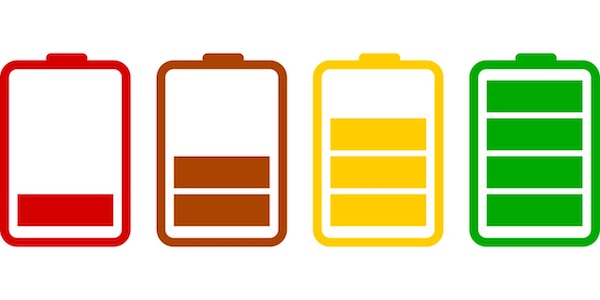
Bluetti’s AC200 houses a lithium-ion battery while the AC200P has a LiFePO4 battery. The AC200’s battery cycle life is rated at 2,500+ cycles to 80% capacity and the AC200P’s battery is rated at 3,500+ cycles to 80% capacity.
This feature also matters a lot in the functionality of a portable power station. It helps determine the cycle life of the battery in the solar generator and its overall efficiency. This feature is one of the most important differences between the two solar generators under review.
The Bluetti AC200 uses a lithium-ion battery. This type is one of the most efficient in the solar energy industry. It is better than the lead-acid battery type and only second to the LiFePO4 batteries in terms of efficiency. The AC200 battery also comes with an impressive 2,500+ battery lifecycles.
This cycle life rating is the highest that the industry has seen when it comes to lithium-ion batteries. This means that the AC200 will last longer than its lithium-ion solar generator peers. For example, most of Goal Zero’s and Jackery’s li-ion solar generators have 500 cycles to 80% capacity.
For the newer version, the Bluetti AC200P thumps the AC200 in terms of battery longevity. It uses a lithium-iron-phosphate battery type. This battery, also known as LiFePO4, is the best type of battery in the solar energy industry. It tops the chart with efficiency, cycle life, strength, and durability.
The AC200P’s battery boasts an impressive 3,500+ lifecycles.
Verdict: It is a clear win for the Bluetti AC200P in this section. It possesses a superior battery type and this, in turn, gives the battery better efficiency and longer-lasting lasting cycle life.
Charging Mechanisms and Duration of Bluetti’s AC200 & AC200P
Both the AC200 and AC200P have the same charging stats for all three charging methods. The power ratings for each charging method are:
- Solar Input: 700W max
- AC Wall Charger: 400W per charger
- Car Charger: 100W (12V); 200W (24V)
The solar and wall inputs can also be used simultaneously for a faster charge.
While portable power stations are a source of electricity themselves, they require basic battery charging to enable their functions. To a very large extent, the efficiency and speed of the charging mechanism determine how much you can get out of your solar generator.
As an example, say you have a 3,000Wh solar generator that takes in a maximum of 400W of solar panel charging input. On average, you’ll get about five hours of good sunlight every day. If you’re using this system completely off the grid and can only charge from solar panels during the day, 400W times five equals 2,000Wh of battery charge on an average day.
Since you cannot charge the system to its full battery size (3,000Wh) during a standard day, you will not be able to use the generator to its full capabilities. If you did, you would run out of battery before you could recharge it.
This is why having a high solar input is important for larger solar generators – Because you want to be able to recharge the system from zero to a full battery in a single day’s time.
As with most solar generators, both the AC200 and AC200P have three primary charging mechanisms. These mechanisms include solar charging, car charging, and wall charging. Solar charging in these systems is supported by MPPT technology. With this innovation, solar generators will be able to get more efficient input power from solar panels compared to a standard PWM charge controller.
Since the AC200 has a 300Wh smaller battery than the AC200P, it will charge slightly faster than the AC200P with each charging method.
AC200 Charging Times
- Solar (700W): 3-3.5 hrs
- AC Wall (400W): 5-6 hrs
- Car (100-200W): 8.5 hrs (24V); 17 hrs (12V)
- Dual AC Wall (800W): 2.5-3 hrs
- Solar + AC Wall (1,100W): 2-2.5 hrs
AC200P Charging Times
- Solar (700W): 3.5-4 hrs
- AC Wall (400W): 6-7 hrs
- Car (100-200W): 10 hrs (24V); 20 hrs (12V)
- Dual AC Wall (800W): 3-3.5 hrs
- Solar + AC Wall (1,100W): 2.5-3 hrs
As seen from the stats above, you can charge either system from dual AC chargers and from solar and a single AC charger together. The solar and AC combined charging method is the fastest charging method at 1,100W. For the dual AC charging method, you will need to buy a separate cable and wall charger to accomplish this.
Verdict: The Bluetti AC200 is the faster-charging solar generator due to the AC200P’s larger battery. Since the charging methods and power ratings are all the same, the battery size makes all the difference in this comparison.
Number of Ports – AC200 vs AC200P (Inputs & Outputs)
The primary determinant of the usability of a power station is the number of ports available on the body of the solar generator. The number of ports will determine the number of devices that you can power both individually and simultaneously with the portable power station.
The AC200 and AC200P have the exact same port setup. Below are all of the ports on each system.
- Six 100-120V AC outlets 2,000W (4,800W surge)
- One DC cigarette lighter output port (12V/10A)
- Four standard USB-A outputs (15W each)
- One USB-C PD output (60W)
- Two wireless charging ports (15W each)
- Two standard DC outputs (12V/3A)
- One RV DC port (12V/25A)
- One solar (PV) input port (also functions as the car input port)
- One AC adapter input port
Verdict: It is also a tie in this section as both power stations have the same numbers, arrangements, and ratings when it comes to ports and outlets.
LCD Screen Embedded in the AC200 and AC200P
One of the coolest and most innovative features of the AC200 and AC200P is the LCD touchscreen. These models are special in this regard as most solar generators do not have touchscreens. This allows for a much easier user experience when utilizing all of the different features of the touchscreen.
There are several different capabilities of the touchscreen, but the main functions that are crucial in a solar generator are all available. These functions include how much power is flowing in and out of the system and battery life.
Additional functions include a “settings” section, which lets you review the AC output voltage and frequency, DC input source, as well as “Eco Mode”, which can run your system more efficiently to support the longevity of the battery.
There are two other functions labeled “Data” and “Faults”. The first section gives you information on the entire system, including the inverter, charger, BMS (Battery Management System), and the fault history of the solar generator. The “Faults” section shows you any malfunctions within the generator to easily distinguish the issue to resolve it.
Verdict: Both systems have the same touchscreen, so there is a draw in this category.
Conclusion
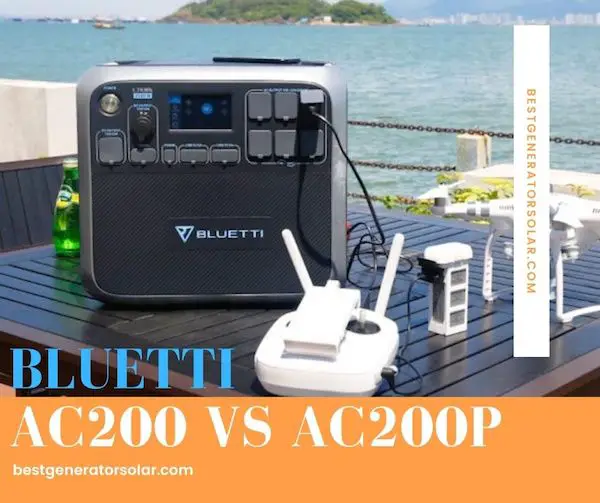
Both the Bluetti AC200 and AC200P are excellent solar generators.
They both possess impressive features including strong batteries with a high number of charge cycles, excellent inverters, and numerous charging options.
However, the AC200P comes out on top because of its battery type. The solar generator uses a LiFePO4 battery which is the best battery type in the industry to date.
It has a longer cycle life by at least 1,000 charge cycles. Plus, the AC200P’s battery is 300Wh higher in battery capacity, giving it a second advantage over its predecessor.
The above is an affiliate link, where I make a small commission on every sale.





